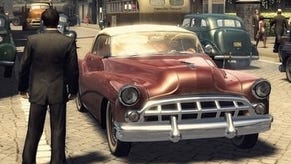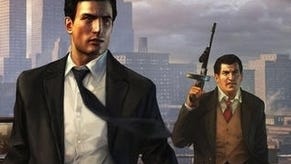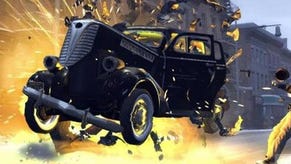Mafia II
Crime doesn't play.
The remarkable thing about Mafia II is not that it's bad, but that it masks its awfulness so well. The game opens with striking visuals: the backdrop of Empire Bay (Mafia's stand-in for New York City) is packed with World War II-era details, and the characters are authentic-looking, with a veneer of humanity. The nicely curated oldies soundtrack promises to immerse us in the culture and spirit of the period. Mafia II has the production values that players interpret as signs of quality. What comes next is cognitive dissonance.
Playing this Potemkin village of a game is an eerie experience. Mafia II puts up such a convincing facade that it's hard to believe Empire Bay is, in fact, practically empty. Even after four hours of play, I told myself, "Once I get past these boring tutorial stages, the actual game is going to be great." As I slogged through a mission to canvass Empire Bay's local gas stations and sell off extra fuel stamps, the truth dawned on me: This was the actual game. Mafia II was having me play stamp salesman, and it wasn't even kidding.
2K Czech's developers have dressed up their latest title to masquerade as a vast, Rockstar-style open world, and a pretty masquerade it is, too. But the reality is that Mafia II strings the player through a couple of dozen mandatory missions, all of them straight out of the Grand Theft Auto reject pile, and the potential for exploration is nil.
You can sometimes ignore your current objective and drive around, but why would you? There's nowhere to go. The map's points of interest are almost useless, like clothing stores that feature a handful of drab outfits. Likewise, there's nothing behind the pretty face of protagonist Vito Scaletta, a charmless zero who does whatever he is told to do no matter who asks, obliging all corners of the Empire Bay organised-crime machine with his robotic smile. Rough up some innocent dockworkers? OK. Switch families? You got it. Deal drugs? No problem. He does have occasional moments of rebellion, but because of the character's general vapidity, they ring false.
Vito's buddy Joe is supposed to be the dumb one, and indeed, like most of the characters in Mafia II, he is a detestable cretin. At least Joe has some sense of self-agency, though. He's the one that hatches the plans and lays the groundwork for Vito's career; our hero simply follows Joe's lead.
Given that he's such an unimpressive recruit, it figures that the mob enlists Vito to do their most mundane errands. Whenever a capo needs someone to drive from point A to point B, Scaletta's their man. You hit the asphalt for meeting after meeting, with the occasional fight tossed in whenever the developers felt the need to make something actually happen (a relatively rare impulse).
Vito mostly finds himself behind the wheel of lumbering saloons, whose slowness exacerbates the game's boredom. You can soup up the cars at a body shop to give them more pep, except the police will try to pull you over if you drive at speeds over 55 or so, always ready to stamp out any marginal excitement that might occur. They are, in fact, a bit less aggressive than in the original Mafia. That's small consolation, though, when your mission is derailed yet again by the obligation to drive in circles and shake the idiot cops.
The joys of the open road are punctuated with battles, typically fought with fists or guns. The hand-to-hand combat could be described as Double Dragon For Idiots. In essence, there is one move - dodge, then counterpunch - and it will carry you through every fistfight. The rhythm is so simple that you can practically fight blind, which is lucky, as the camera has a fetish for the pugilists' upper backs.
During shootouts, the player ducks in and out of cover to gun down waves of armed assailants. It's pretty standard fare, executed with Mafia II's trademark clumsiness. While the settings vary, the stultifying, unimaginative use of space is consistent. You're almost always slogging down a corridor, picking off jack-in-the-box thugs who pop into view every couple of seconds.
That might be for the best, because when the game does diverge from that template, the results are even worse. The interiors are too nondescript, which means that in anything but a hallway, it's easy to get lost amid the sameness. In practice, getting lost for even a moment tends to result in an instant-death headshot.
Other design missteps abound. The movement controls are restrictive - Vito's sprint is more of a jog - but they are at least adequate. The same can't be said for the mini-map radar, whose unpredictable scale makes it useful only for determining if there are enemies in your general vicinity. And often, it even fails at that, showing phantom bogies that are actually far removed from your locale (down in the basement, for instance).













